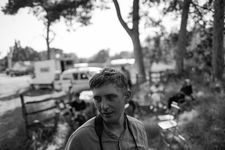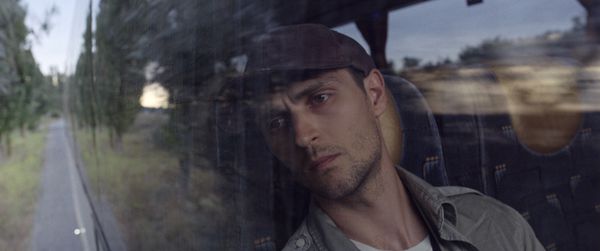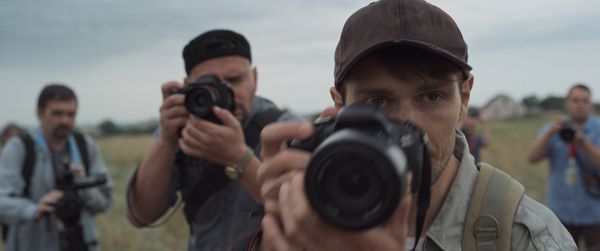Ukrainian director Roman Bondarchuk and his co-writers, Alla Tyutyunnyk - who is also the filmmaker’s mum - Dar'ya Averchenko return to the southern Ukraine for their satirical and often surreal follow-up to 2018’s Volcano. Like their first film, the action centres on a protagonist who becomes a sort of innocent abroad in events he can’t quite wrap his head around or extract himself from.
Yuri (non-professional actor Dmytro Bahnenko, in whose real-life experiences the film is rooted), is a biologist on the trail of rare steppe marmots when he witnesses a group of arsonists starting a forest blaze. His bid to expose the culprits sees him sucked into a world of fake news and political gamesmanship in the chaotic, pre-Russian invasion Kherson region.
The crux of the film hinges on truth and lies. Not just the prevalence of fake news but the willingness of people to believe it over the real deal. In one scene in the film, for example, a journalist explains to Yuri how to fictionalise a news story about a woman falling from a tower block, embellishing it as it goes.
As a problem, Bondarchuk says: “I think it's quite universal. It's getting more and more difficult to get the truth in the scale of this world. Russia is maybe the worst example. It's too surreal and too cruel to be described anywhere but the upcoming American elections will probably be even more sophisticated than this film and this provincial, Ukrainian editorial office. I think false news, manipulations, it's something everywhere, and we just had the opportunity to study this phenomenon in an example of a small place and small situations, which I know well, and which was interesting to me to, to put my lens on and to follow the reasons for it and the consequences.”
Despite how surreal Bondarchuk’s film sometimes feels - including scenes involving an American cryptocurrency guru and even a Wicker Man moment - the filmmaker, whose background is originally in documentary, says that much of it is based on factual research, which he says gives him “confidence”. Speaking about the act of arson that begins the movie he notes that there are those who profit from the wood after these sorts of blazes.
 |
| Roman Bondarchuk on fake news: 'It's getting more and more difficult to get the truth in the scale of this world' Photo: Olesandry Technynskyi |
This real exploitation is how the director came to meet Bahnenko, a young investigative journalist, who would go on to take the lead role in the film and who wrote several articles about this criminal enterprise.
As a result, Bondarchuk says: “He was really persecuted by those people and they own some public and social media and they started to call him gay and some other dirty things and campaigns against him. I was interested to meet him and once I met him, we decided to do this research for the script.
“I took a camera and took dozens of interviews with local journalists and people who call themselves political advisors on that provincial level. And during this research, we became friends. And it was quite fun to meet them all and to ask them questions and to know the highs of their careers and even headlines of their articles, which most of them are true. The piece about a woman who jumped out from the window is a 100% real, fictionalised article and the rest are also rooted in that reality. Then when it came to casting, I realised that it's difficult for me to cast another person. So we decided to arrange classes for Dima and for Zhanna Ozirna, who plays Lera (a feminist journalist in the film). We sent them for two months, we took away their smartphones and asked them not to be active in social media to become the characters not as journalists or the people they used to be before.”
Another real-life person in the film is a man we see on a motability scooter, who repeatedly paints “Put is a dickhead” on a fence in the film.
“He's a real volunteer, he managed to raise millions for the Ukrainian army since 2014,” says Bondarchuk. “And even after the occupation of Kherson, he used to raise money for the Ukrainian army in the occupied city with his Bluetooth speaker. He was riding through Kherson central market with the Ukrainian anthem on he speaker and no one dared to harm him because he was a disabled man in a wheelchair. And it's such an example of resistance. Some other people took him out of the city when it became really, really dangerous for him. But he managed to raise money for the Ukrainian army even in occupation. So there are heroes. I think many of our characters who I thought were hopeless and completely indifferent to any kind of politics, were forced to take a position and to express their actual opinion [after the invasion].”
Speaking about the collaboration between himself and his co-writers, Bondarchuk says: “I read an article on how artificial intelligence works. And the system is very similar to how we work together because artificial intelligence always tests if this idea may work or not, and when it's like three people in the room, the bad ideas, they can be discussed and can be accepted or rejected faster.
“The idea has to be very good and has to work in the scope of the whole script to be accepted by three people. It comes from lots of research material, lots of videos and transcriptions and written texts. And then we try to build some islands and some episodes we think may work and then we try to build the storyline between those islands, tto create the plot. It’s always from documentary observations, but then it's somehow moving to structure and then we Alla, who writes the dialogue better than we do because some of the dialogues also come from notebooks and those are the best.”
And the director is full of praise for his journalist mum. “She's the one who supported me when I started writing my first short stories. At the age of 13, probably, we had a typewriter at home and I was attracted to it firstly, because it's like quite an interesting mechanical device and I just was fascinated by typing the buttons. Somehow, she helped me to get my eye in and focus on stories and how to describe my day, what was happening there. And that's how I started to write.
“Then it was the Nineties, with the collapse of everything, we were very poor and she was focused, like the whole family was focused, on how to survive and what to eat tomorrow. After that, of course, no one needed any writers or journalists. So this job wouldn't bring any money. So she switched to public activities and she started her NGO to help people with legal problems and so she became like a civil activist instead of writing. And when I graduated from my film school, I always wanted to bring her back because I was a big fan of your books and your pieces. So this is my way to push and somehow inspire her to think about writing and to express your talent.”
Turning to some of the specifics in the film, the director also explained how tricky it was to achieve a shot near the start in which the fire is set and we see animals fleeing from the forest.
“It was quite ambitious to write the scene in the script at the beginning, but we always wanted to test the limits,” he says.
Due to his documentary background he initially wanted to shoot the scene live in Ukraine.
He explains: “The idea was to build a corridor to limit the animals and for the animals to run toward the camera, and then to erase the corridor and put the real animal into the real scene. But the problem was that animals refused to run towards the camera. They were afraid.”
He says they tried to camouflage the camera and even spoke to animal trainers in Germany thinking, “maybe there is more order in Germany, we can somehow persuade animals to do what we need to them to the end”.
It turns out that German animals are no better behaved and so in the end they were forced to go down the CGI route.
The other animal that is noticeable in the film is Jonathan Livingston Seagull, who is heard on tape at several points. Bondarchuk says the attitude to Richard Bach’s allegorical fable about freedom and self-fulfilment is considered in a very different way by Ukrainians than elsewhere.
“It’s funny,” says Bondarchuk, “And I think that’s reason enough to have it there.” He says he first came across the book when his dad bought a copy in the Nineties.
He recalls: “He said, ‘Look, this is a very popular piece of Western literature’. And it was like a brochure, you could read it in an hour or 20 minutes. And I was so surprised that this extremely direct and simple piece can become so important. Later on, I felt like it's a Bible, a role model for new Ukrainian businessmen. This book became, well, a permission to do whatever they want. So the main idea, the message of this book to Ukrainian enterpreneurs was, ‘There are no limits. You can do whatever you want to do’. Somehow it became I don't know. Religious, I think it became religious, despite the fact that it's very simple and obviously not the best piece of literature at all. I liked this paradox.
For the. For us, it's something very important but Heike Parplies, the editing consultant who helped us to shape this film in the end asked, ‘Why the hell's Jonathan Livingston Seagull here?’ and I told her this story of new Ukrainian enterpreneurs? And she says, ‘Oh, that’s interesting, in Germany it’s just a book for kids’. So that's our cultural difference, probably. But it's a good way to explain it.”
Although the film is set before the Russian invasion, and was mostly shot in the period prior to that as well, the shadow of the impending conflict is a backdrop for the film. The war also had a tragic impact on the film itself, with the loss of editor Viktor Onysko, who was killed in action while defending Kherson in December 2022.
Bondarchuk notes the “steadicam operators are picking up machine guns” now in defence of the country and says he thinks there will be a gap in terms of fiction filmmaking because of the conflict, because “there are not enough people and it's not safe to film them and they are bloody expensive”
He adds: “All the money goes to the army now. But I think it will be okay. There's documentaries. Hopefully the international funds and bodies will be supportive toUkrainian applications because inside Ukraine it's really really tough.”























